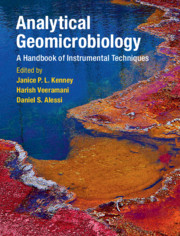Book contents
- Analytical Geomicrobiology A Handbook of Instrumental Techniques
- Analytical Geomicrobiology
- Copyright page
- Contents
- Contributors
- Foreword
- Part I Standard Techniques in Geomicrobiology
- Part II Advanced Analytical Instrumentation
- Part III Imaging Techniques
- 5 Scanning Probe Microscopy
- 6 Applications of Scanning Electron Microscopy in Geomicrobiology
- 7 Applications of Transmission Electron Microscopy in Geomicrobiology
- 8 Whole Cell Identification of Microorganisms in Their Natural Environment with Fluorescence in situ Hybridization (FISH)
- Part IV Spectroscopy
- Part V Microbiological Techniques
- Index
- References
7 - Applications of Transmission Electron Microscopy in Geomicrobiology
from Part III - Imaging Techniques
Published online by Cambridge University Press: 06 July 2019
- Analytical Geomicrobiology A Handbook of Instrumental Techniques
- Analytical Geomicrobiology
- Copyright page
- Contents
- Contributors
- Foreword
- Part I Standard Techniques in Geomicrobiology
- Part II Advanced Analytical Instrumentation
- Part III Imaging Techniques
- 5 Scanning Probe Microscopy
- 6 Applications of Scanning Electron Microscopy in Geomicrobiology
- 7 Applications of Transmission Electron Microscopy in Geomicrobiology
- 8 Whole Cell Identification of Microorganisms in Their Natural Environment with Fluorescence in situ Hybridization (FISH)
- Part IV Spectroscopy
- Part V Microbiological Techniques
- Index
- References
Summary
Geomicrobiological samples obtained from the natural environment or from laboratory-based experiments often contain microbial cells, primary minerals, and/or (biogenic) secondary minerals as extracellular precipitates on cell surfaces. The advantage of transmission electron microscopy is that it provides high-resolution imaging of ultrafine structures of cells and minerals. Transmission electron microscopes can be equipped with a range of microanalytical tools, such as selected area electron diffraction and energy dispersive spectroscopy, that complement the imaging capacities of the electron microscope. These two analytical techniques are used to characterize the crystallography and chemical composition of (secondary) minerals, respectively. In addition, lift-outs that have been focus ion beam milled from rock-like materials are analogous to ultrathin sections and can be characterized in a similar manner using transmission electron microscopy. This chapter will demonstrate conventional techniques for preparing samples as whole-mounts and ultrathin sections, which provide a three-dimensional and two-dimensional perspective of samples, respectively. Whole-mounts and ultrathin sections are the most fundamental sample preparation techniques that can be used to characterize geomicrobiological materials. Therefore, in geomicrobiological studies, transmission electron microscopy is an ideal technique to demonstrate and interpret the structure–function relationship of how microbes contribute to the biogeochemistry of a given system.
- Type
- Chapter
- Information
- Analytical GeomicrobiologyA Handbook of Instrumental Techniques, pp. 166 - 186Publisher: Cambridge University PressPrint publication year: 2019
References
7.9 References
- 1
- Cited by

